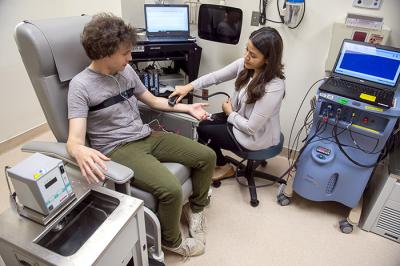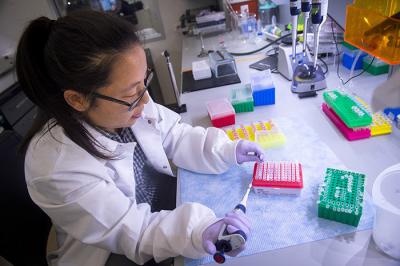A Feel For Collaboration
Alex Chesler works with colleagues across the IRP to uncover the mysteries of touch and pain.

Dr. Alex Chesler
Most people watching the young woman repeatedly try — and fail — to touch her own nose while blindfolded would merely shrug and think, “That’s odd.” After all, it’s hard to imagine the profound difficulties that result from a loss of proprioception, the so-called ‘sixth sense’ that allows us to keep track of where the various parts of our bodies are in space. However, when Alex Chesler, Ph.D., met this remarkable patient, he immediately understood her unique struggles, as well as the hugely important scientific insights her condition could yield.
In 2013, Dr. Chesler had just started up his lab at the NIH’s National Center for Complementary and Integrative Health (NCCIH) after spending his postdoctoral years at the University of California, San Francisco, trying to figure out how our skin transmits information to our brains about the objects we touch. His experiments had revealed a great deal about how our skin detects temperature, but the mechanisms behind other facets of our sense of touch remained more mysterious.

Senior research fellow Eleni Fragos conducts sensory testing with a volunteer in the NIH Clinical Center.
“Your fingers are so sensitive to the gentlest touch or the slightest vibration, yet how the body accomplishes this was completely unknown,” says Dr. Chesler. “At the molecular level, we had not identified a touch receptor and we had no real insight into how we can detect mechanical forces with such amazing acuity.”
Naturally, Dr. Chesler was not the only scientist searching for the elusive touch receptor, and in 2010 he was somewhat disappointed to learn that a competing lab had discovered that a molecule called PIEZO2, produced by a gene of the same name, plays a key role in the sense of touch. Not one to be deterred, Dr. Chesler set out to learn as much as he could about the newly discovered molecule.
When he moved to the NIH to start up the NCCIH’s Section on Sensory Cells and Circuits, Dr. Chesler planned to use what he calls “the standard approach” to study PIEZO2: examine how the molecule works in cells and investigate what happens when cells and mice don’t have it. However, shortly after arriving at the NIH, Dr. Chesler learned that one of his new IRP colleagues, Dr. Carsten Bönnemann, a senior investigator at the National Institute of Neurological Disorders and Stroke (NINDS), had identified a handful of people with extremely rare mutations that caused their PIEZO2 genes to stop working. The two immediately began working together.
“All of a sudden I went from being your standard mouse-studying neuroscientist to being in the NIH’s Clinical Center with Carsten and meeting people who had a complete loss of function in this gene I was interested in,” Dr. Chesler says. “This really flipped the script on me. Through Carsten, I met my first human lacking this gene before I managed to produce my first mouse lacking it. It was really quite an extraordinary chain of events.”
This video of a woman with a PIEZO2 mutation shows how her lack of proprioception makes it difficult for her to touch her own nose or maintain her balance while blindfolded.
Without PIEZO2, Dr. Chesler and Dr. Bönnemann found, the participants in their study cannot feel vibrations or gentle touches on their skin and completely lack the sense of proprioception that virtually everyone takes for granted. As a result, they can’t find and touch objects or even their own noses while blindfolded, and they also have trouble keeping their balance while walking unless they can see their legs and feet. Perhaps most importantly from a clinical perspective, they do not develop the increased sensitivity to pain that people normally experience when their skin is damaged by an injury like a sunburn. This suggests that treatments targeting PIEZO2 could relieve the pain hypersensitivity that afflicts millions of chronic pain patients in the United States.

Postdoctoral fellow Marcin Szczot uses two-photon imaging to examine sensory responses in the mouse brain.
“Through my work with Dr. Bönnemann and these patients, I rediscovered one of the most trivial truths in science: mice can’t talk, but people can,” Dr. Chesler says. “We can ask these people questions about their daily lives and experiences, bring that information back into the lab, and use our cell models and animal studies to really delve deep into the mechanisms and try to explain the clinical observations that Carsten and his team make and the life stories that we are able to get from these people and their loved ones.”
Of course, human biology is never simple, and studying PIEZO2 made it clear that it is not the only molecule involved in our sense of touch. Nowadays, in addition to continuing to study PIEZO2, Dr. Chesler’s lab uses advanced imaging techniques and animal behavior experiments to investigate the various types of sensory neurons in our skin and the pathways they use to send information to the brain. In recent years, his research team has made significant discoveries about how certain types of sensory neurons transmit signals about temperature and pain, as well as a part of the brainstem called the parabrachial nucleus that processes those signals.

Graduate student Ruby Lam shows off her pipetting skills at the bench.
Dr. Chesler also continues to pursue the kind of collaboration with his IRP colleagues that he has enjoyed with Dr. Bönnemann. For several years, he has worked with Drs. Mark Hoon, Claire Le Pichon, and Nick Ryba to study neuropathic pain, a form of chronic pain that results from damage to nerves outside of the brain and spinal cord. Like Dr. Chesler’s and Dr. Bönnemann’s work on PIEZO2, this research combines the expertise of investigators across the NIH in pursuit of discoveries that could one day help alleviate chronic pain. In 2020, the team welcomed a new member: IRP Stadtman investigator Yuanyuan “Kevin” Liu, an expert on how the brain influences pain perception.
“This sort of collaboration is really what fuels me,” Dr. Chesler says. “I absolutely love talking about science. I love talking about ideas. I love hashing things out. I love thinking about data. I think the best way to do that is in conversation with brilliant people, and there’s just so many of them at the NIH. It’s just a great place to do that.”
Alex Chesler, Ph.D., is a Senior Investigator in the Sensory Cells and Circuits Section at the National Center for Complementary and Integrative Health (NCCIH).
This page was last updated on Wednesday, May 24, 2023